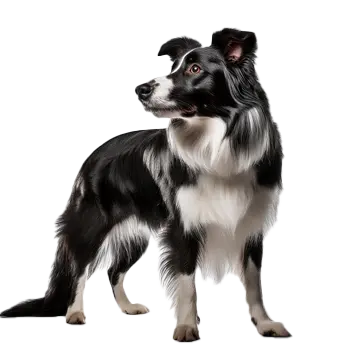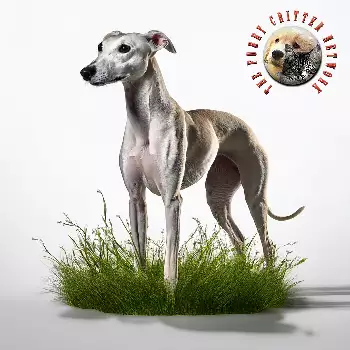Border Whipollie
Hybrid Breed Description
The Border Whipollie is a cross between the Border Collie and the Whippet. Because each hybrid inherits a unique combination of traits from both parents, we recommend thoroughly researching both breeds before choosing a Border Whipollie. Pay special attention to temperament, health issues, and care requirements, as your dog may express characteristics from either parent breed.
Border Collie

Border Collies are medium-sized, athletic dogs with a strong, agile build on a lean frame. Males typically stand between nineteen to twenty-two inches at the shoulder and weigh thirty to fifty-five pounds, while females are slightly smaller at eighteen to twenty-one inches tall and twenty-seven to forty-two pounds. They possess a muscular yet graceful body structure that reflects their herding heritage, with well-proportioned features designed for endurance and agility. Their body is slightly longer than tall, with a deep chest, straight strong back, and medium-length tail that reaches the hocks. The Border Collie's double coat can vary from smooth to rough in texture, with some dogs displaying feathering on the forelegs, chest, and underside. While black and white remains the most iconic color pattern, these dogs come in virtually every color combination imaginable, including red and white, blue merle, tri-color, sable, and brindle varieties. Their expressive, almond-shaped eyes are typically dark brown but may be blue or amber in merle-coated individuals. Distinctive features include their alert, intelligent expression and semi-erect or fully erect ears that tilt forward when attentive. Their heads are relatively broad with a distinct stop and a tapered muzzle of moderate length. Border Collies move with exceptional grace and fluidity, displaying their legendary agility and speed. Their athletic build and keen expression combine to create a dog that appears perpetually ready for action, embodying the breed's renowned work ethic and remarkable physical capabilities.
Key Characteristics
Border Collies are widely recognized as one of the most intelligent dog breeds, possessing an exceptional ability to learn commands, solve problems, and anticipate their handler's needs. This remarkable intelligence comes with high energy levels and an intense work drive that were carefully cultivated through generations of herding sheep in challenging terrain. They thrive in environments where they receive ample mental stimulation and physical activity, often excelling in dog sports such as agility, obedience trials, herding competitions, and flyball. Without adequate outlets for their boundless energy and sharp minds, Border Collies may develop destructive behaviors or become anxious. These dogs form deep, loyal bonds with their families and are known for their sensitivity to human emotions and subtle cues. They often choose a favorite person and prefer to stay close to their loved ones throughout the day. Border Collies are gentle with children when properly socialized, though their strong herding instincts may lead them to nip at heels or attempt to control movement. They can be reserved or cautious around strangers, making early socialization crucial for developing a well-rounded temperament. Border Collies are highly trainable and eager to please, responding best to positive reinforcement methods and consistent, patient guidance. Their intense focus and determination make them outstanding working dogs, but these same qualities require owners who can provide firm, confident leadership without harsh corrections. They need owners who understand their need for purpose and can channel their intelligence and energy into productive activities. When their needs are met, Border Collies make devoted, responsive companions who bring joy through their enthusiasm for life and remarkable abilities.
Border Collies are generally considered a healthy breed with a lifespan of twelve to fifteen years, though they are predisposed to several genetic conditions that responsible breeders screen for. Hip dysplasia is the most prevalent hereditary condition affecting the breed, caused by multiple genes interacting with environmental factors such as nutrition and exercise during growth periods. While environmental management can minimize expression of the condition, affected dogs may experience pain, lameness, and arthritis requiring medical intervention or surgery. Eye conditions are another significant concern for Border Collies. Collie Eye Anomaly is an inherited developmental disorder that can range from mild vision impairment to blindness, though many affected dogs retain functional vision. Progressive Retinal Atrophy, while less common in Border Collies than historically believed, can lead to gradual vision loss. Other eye issues include cataracts and persistent pupillary membranes. Regular ophthalmologic examinations can detect these conditions early. Neurological and immune system disorders also occur in the breed. Epilepsy typically manifests before six years of age and may require lifelong medication management. Trapped Neutrophil Syndrome affects the immune system, causing chronic infections and developmental delays in affected puppies. Border Collie Collapse is a breed-specific condition triggering episodes of disorientation and weakness during intense exercise. Additionally, some Border Collies carry the MDR1 gene mutation, making them sensitive to certain medications. Genetic testing is available for many of these conditions, and reputable breeders conduct health screenings to minimize risks. With proper care, regular veterinary visits, and awareness of breed-specific concerns, Border Collies typically enjoy active, healthy lives well into their senior years.
Whippet

The Whippet is a medium-sized sighthound built for speed and elegance, with males standing nineteen to twenty-two inches tall and weighing twenty-five to forty pounds, while females measure eighteen to twenty-one inches and weigh twenty to thirty-five pounds. Their streamlined physique features a deep chest, tucked abdomen, long slender legs, and a graceful arching back that creates a distinctive silhouette. The breed's athletic build reflects its heritage as a racing and coursing dog, with every aspect of their conformation designed for explosive speed and agility. Their narrow, aerodynamic body allows them to reach speeds of up to thirty-five miles per hour. Whippets have a short, smooth, fine-textured coat that lies close to the body, requiring minimal grooming but providing little insulation against cold weather. Their coat comes in virtually any color or pattern, with black, white, brindle, fawn, blue, and red being common, often combined with white markings. The breed standard considers color immaterial, allowing for tremendous variety. Their wedge-shaped head features a long, tapering muzzle and large, lustrous, dark eyes that convey both intelligence and gentleness. Distinctive characteristics include their rose-shaped or folded ears, naturally low tail carriage that curves gently upward when alert, and visible muscle definition beneath their thin skin. Despite their lean appearance, healthy Whippets display well-developed musculature, particularly in their hindquarters and chest. Their elegant, effortless gait demonstrates both grace and power. The breed's refined features, combined with their athletic prowess, create a dog that embodies both beauty and functionality, perfectly suited for their dual role as sprint athletes and affectionate companions.
Key Characteristics
Whippets are gentle, affectionate dogs known for their calm, quiet nature indoors and their explosive energy when outdoors. Often described as having two distinct personalities, they transform from relaxed couch potatoes contentedly snuggling with their families to intense athletes when given the opportunity to run. This breed craves physical closeness and warmth, frequently burrowing under blankets and seeking out the softest spots in the home. They form strong bonds with their families and prefer to be touching their loved ones, making them devoted companions who don't do well when left alone for extended periods. These sighthounds are typically friendly and sociable, though they can be reserved with strangers and may take time to warm up to new people. Early socialization helps prevent shyness and builds confidence in unfamiliar situations. Whippets are generally peaceful with other dogs and can coexist well with family cats when properly introduced, though their strong prey drive means they may chase small animals outdoors. They are remarkably quiet dogs, rarely barking unnecessarily, which makes them excellent apartment companions. Their sensitive nature responds poorly to harsh corrections, and they thrive with gentle, positive training methods. Whippets are intelligent and trainable, though their independent sighthound nature means they may not be as eager to please as some breeds. They excel at lure coursing and enjoy activities that let them sprint, but they're equally content with moderate daily exercise followed by extended relaxation time. Their adaptable temperament suits various living situations as long as they receive adequate physical activity and aren't exposed to extreme temperatures. Whippets are generally good with gentle children but may find rough play overwhelming. When their needs for exercise, affection, and mental stimulation are met, Whippets make wonderfully devoted, low-maintenance companions.
Whippets are generally among the healthier purebred dogs with a lifespan of twelve to fifteen years, experiencing fewer genetic health problems than many breeds. Their athletic heritage and functional conformation contribute to their overall soundness, though prospective owners should be aware of certain breed-specific concerns. Hip and elbow dysplasia are essentially unknown in Whippets, and many hereditary conditions common in other breeds rarely affect them. However, their thin skin and active nature make them prone to lacerations and cuts during high-speed activities, particularly on their slender legs where muscle coverage is minimal. Cardiovascular issues represent one of the more significant health concerns for Whippets. Mitral valve disease is the most prevalent form of heart disease in the breed and the leading cause of death in older Whippets. This condition involves deterioration of the heart's mitral valve, allowing blood to flow backward and potentially leading to congestive heart failure. Regular cardiac examinations can help detect heart murmurs early, allowing for appropriate management. Additionally, while not common, Whippets with their deep chests can develop gastric dilatation and volvulus, a life-threatening condition requiring immediate veterinary intervention. Eye and immune-related conditions also occur in the breed. Progressive Retinal Atrophy, though relatively uncommon in Whippets, causes gradual vision loss, while inherited deafness can be present from birth or develop over time. Some Whippets experience immune-mediated disorders such as hemolytic anemia and thrombocytopenia, where the body inappropriately attacks its own blood cells. Whippets are notably sensitive to anesthesia due to their low body fat and unique metabolism, requiring veterinarians experienced with sighthounds. Despite these potential concerns, most Whippets remain healthy and active throughout their lives with routine veterinary care, appropriate exercise, and protection from temperature extremes and physical hazards.
Important to Remember
Each hybrid dog is unique and may inherit any combination of traits from either parent breed. The information above represents the characteristics of the purebred parent breeds. Your Border Whipollie may favor one parent over the other or display a blend of both. We strongly encourage you to read the complete breed profiles for both the Border Collie and Whippet to fully understand the range of possible temperaments, health concerns, and care requirements.